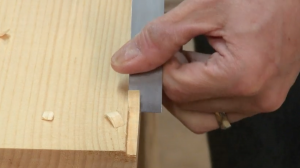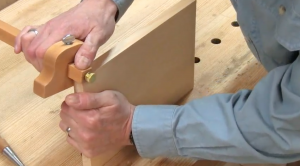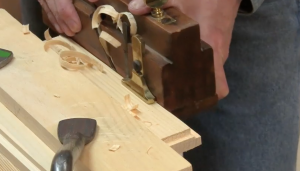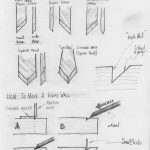We may receive a commission when you use our affiliate links. However, this does not impact our recommendations.
If you are just getting started with woodworking hand tools, you will quickly learn that the ability to cut rabbets is essential for making drawers, casework and many other projects. Drawer bottoms usually sit in dados or rabbets, and drawer fronts can be attached to rabbets in the sides. Cabinetmakers cut rabbets into end panels to accept backs. There are plenty of other applications, so you this should be one of the first joints you learn to make. In this video, Steve Branam shows how to cut rabbets with a chisel or fillister plane. Both techniques are easy to learn, but they will take a little practice to perfect.
Technique 1: Using a Wood Chisel
To cut a rabbet with a chisel, you’ll need to mark the width and depth of the rabbet with a gauge or knife.
 Once you have those two lines scribed, use a chisel with the bevel down to lever out a small amount of material and create a shoulder that will guide the chisel during deeper cuts. Make sure your chisel is super sharp, and be careful not to cut below your depth line. When you’re almost down to the line, flip your chisel over and pare away the remaining material.
Once you have those two lines scribed, use a chisel with the bevel down to lever out a small amount of material and create a shoulder that will guide the chisel during deeper cuts. Make sure your chisel is super sharp, and be careful not to cut below your depth line. When you’re almost down to the line, flip your chisel over and pare away the remaining material.
Technique 2: Using a Fillister Plane
If you are lucky enough to own one of these planes, cutting a rabbet will be a breeze. All you have to do is set the depth and width stops. Just run the plane along the material until the depth stop prevents you from cutting any deeper.
This is a free lesson from Steve Branam’s Popular Woodworking University course, Intro to Hand Tools, which covers all the basic techniques you will need to do just about any project with woodworking hand tools. To learn more about Steve’s course, please visit classes.popularwoodworking.com.
Here are some supplies and tools we find essential in our everyday work around the shop. We may receive a commission from sales referred by our links; however, we have carefully selected these products for their usefulness and quality.










